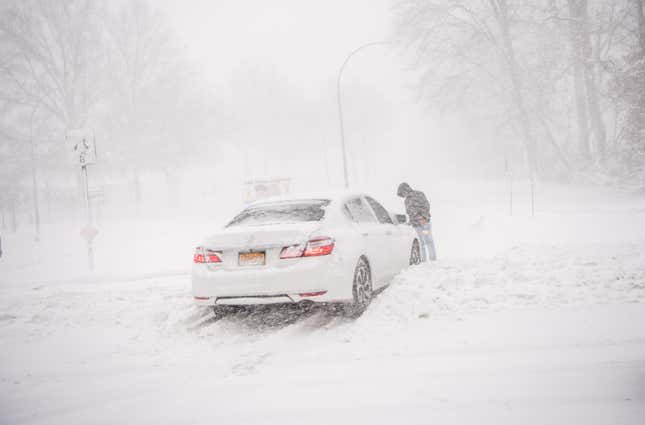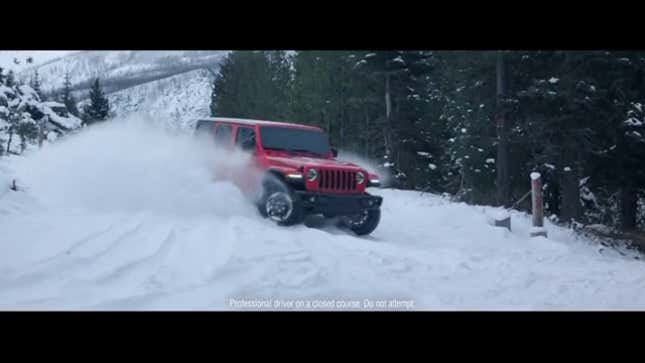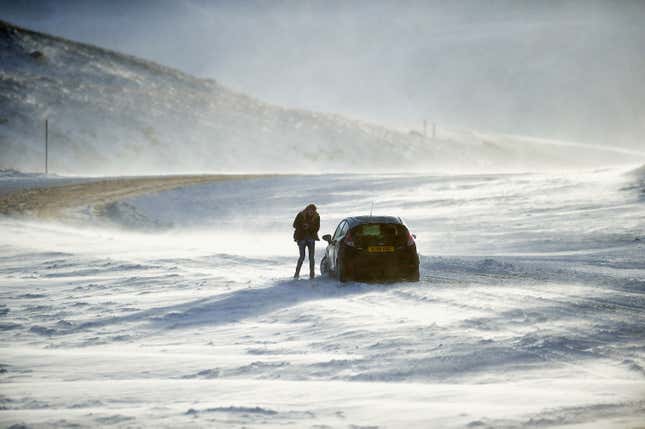We’re a week into November, and the weather is finally starting to change. The crisp, cooling air is beginning to carry the first hints of that distinctive smell of snow. Across the northern United States, perfectly practical Civics and Corollas are being retired for Jeeps, Subarus, and pickup trucks. It’s a sure sign of the season — as natural as birds and rich New Yorkers flying south, people want all-wheel-drive in the snow. Here’s the thing: you’re all wrong.
For a Take like this, I feel like I should show you dear readers my credentials. Any Floridian could say that AWD in December is overkill; while they’d be right, they may not know why. Luckily, I’m no Floridian: I was born and raised in Connecticut, spent my college years in Western NY with its lake-effect snow, and currently live in Brooklyn. I’ve driven every typical combination of powered wheels through winter (if Morgan wants to supply me a three-wheeler, I’ll tackle the atypical ones too), and my only car for the past few winters has been a rear-wheel-drive Scion FR-S. I know snow.
I’ll also give a few caveats to temper the take. If you’re regularly climbing poorly-paved ski mountains covered in deep snow, AWD is probably good for you. If you’re often tackling rutted pavement (especially on inclines) with big ice patches, you probably want more driven wheels. If you’re experienced in low-traction scenarios, you really understand and know how to manage the limits of grip, you’ll probably see the benefits of all-wheel drive. The rest of you, the commuters, don’t need all-wheel-drive at all. Sorry, Subie Squad.

The Traction Problem
The key issue with snow driving is, obviously, a lack of traction. Ice and snow are slippery, and you (usually) want to avoid slipping as much as possible. AWD is advertised as the ideal way to do that, an all-conquering system that will never leave you stranded. But, by sheer virtue of driving all four wheels, AWD can do more harm than good when it comes to grip.
If you’ve ever taken a motorcycle safety course, you know all about the limits of traction. Every tire only has so much grip, and as you add more loads to the tire, you can use that grip up quickly. If you brake hard, for example, you may use up 100% of the grip your tire has to offer; if you brake and try to turn, the loads may be too much — the tire may give up and slide out, yielding understeer.
While those limits most often come up while discussing leaning a bike over, they still exist in cars. It’s why your Camry has ABS: to prevent your car’s full braking force from overwhelming your tires’ grip. The front tires of a car already have a lot asked of them — they provide most of a vehicle’s braking grip, and they have to manage steering. If you’re also going to demand that they put power to the ground, you’re more likely to run out of available traction.
When the front tires of a car lose traction, you end up with a situation called understeer: your steering wheel is turned as far as it can go, but the car plows on straight ahead. With severe understeer, you more or less entirely lose control of the direction your car is moving until you can recover that front-end grip. That can be terrifying on ice and snow, when the road turns a corner but your car simply won’t. Why make it more likely by putting power through the front wheels?
I can hear you yelling at your screen already. “But Steve, my car is FWD, I’m already dealing with those issues!” First off, I wouldn’t recommend getting into the habit of raising your voice at your computer like that; most writers can’t hear you and you’ll just hurt your throat. Second, adding power to the rear wheels won’t do anything to solve those issues up front. Yes, some modern torque-vectored AWD systems will selectively route power to different wheels in order to maximize your grip when turning and even to help you rotate, but very few will fully decouple the front end to leave those tires free for steering. AWD is, primarily, about putting power to the ground through more wheels rather than fewer. Which, actually, leads us nicely into the next section.
A One-Trick Pony
All-wheel-drive in the snow is a Steve Jobs situation: It does one thing well. It won’t help you stop any faster with limited grip. Forcing your front tires to add power while turning certainly won’t help you steer. No, AWD really only does one thing: it helps you go.
To a degree, that’s a good thing. In the words of acclaimed automotive expert Mona Lisa Vito, “Anyone who’s been stuck in the mud in Alabama knows, you step on the gas, one tire spins, the other tire does nothing.” Snow is the same way — with only one tire delivering power to the ground, just one patch of ice can mean you’re stuck. You can get up to two with a limited-slip differential (of which Positraction is a brand name, like Kleenex) but wouldn’t even more be better?
Not always. Simply put, getting a multi-thousand-pound block of metal moving without any reliable way to steer or stop isn’t the flawless idea you may think it is. AWD can certainly get you out of your house, but it may just get you into a bad situation — and offer you no help in getting out.

You’re Not Wrong To Think AWD Helps
After all, that’s what you’ve been told for years. Companies have positioned all-wheel-drive and four-wheel-drive as must-have functionality for winter driving. They’ve even gone so far as to say you need it in the rain. We all know that’s absurd, made up to sell Prii, but we’re so used to snow-based marketing that we don’t really think any deeper about it.
Selling AWD as a necessity for snow makes sense for automakers. AWD generally has more parts and complexity, which translates to more cost — cost that is passed on to the consumer, who is often forced to buy a bunch of other stuff to get all-wheel drive (as the feature is sometimes limited to higher trims). When most of the United States gets snow, and most folks know it’s more challenging to drive through, why not use that fear as a selling point?
Of course, that association between AWD/4WD and unassailable grip gives way to one of the biggest dangers of winter driving: a false sense of security. Hundreds of advertisements showing cars powering through snowdrifts make that link in people’s minds — AWD will give you perfect grip, all the time. That’s the unearned confidence that makes people brake too hard, turn too quickly, and lose control — to the untrained driver, that confidence does more harm than good.

The Key Is Keeping Control
You don’t just want to get out into the world when it’s snowing, you want to make sure your car is controlled while you’re out there. Maximizing grip is important, but so is learning to work with what grip you have.
To maximize grip, start with winter tires. Most people know, or can guess, that the tread pattern on a tire built for the snow is different from one built for dry pavement (the tread includes sipes, which grab onto ice). What many people don’t know is that winter tires are made from softer rubber to deal with winter temperatures. Rubber gets hard in the cold, and hard rubber tends to offer less traction. Winter tires are made softer, so they’re less affected by cold temperatures. They wear quickly in the summer, but they’re what you want in January.
No matter how much traction you have, however, you always need to be careful with how you treat a car in low-grip situations. Don’t mash the pedals or crank the wheel — be gentle, smooth, and the car will be less likely to give up its limited traction.

As the days get colder and shorter, you’ll see more and more advertisements warning you about the dangers of two-wheel-drive cars in the winter. For some people, rally drivers and rural dwellers and snow-sports enthusiasts, the benefits of all-wheel drive are real and tangible. For the rest of us, AWD just means a more expensive car, more money spent on gas, and perhaps not a much better winter driving experience.